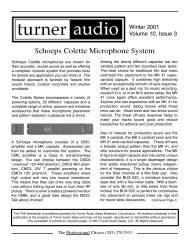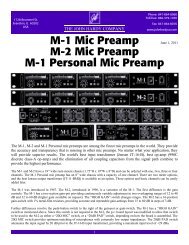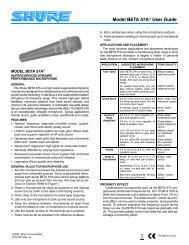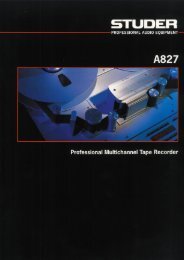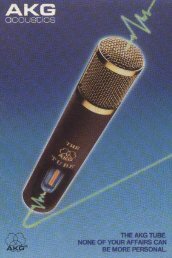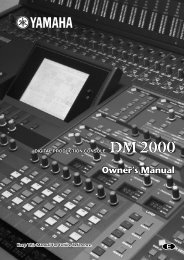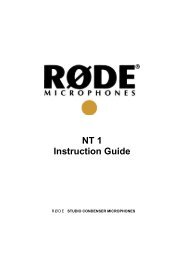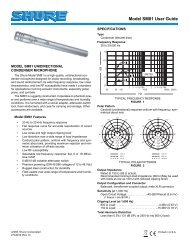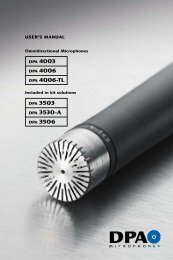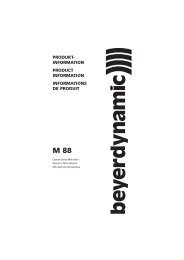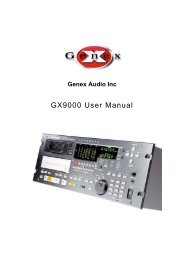Lexicon 480L | PDF - Freeverb3
Lexicon 480L | PDF - Freeverb3
Lexicon 480L | PDF - Freeverb3
You also want an ePaper? Increase the reach of your titles
YUMPU automatically turns print PDFs into web optimized ePapers that Google loves.
Banks 1-4: the Reverb Programs<br />
0 dB<br />
-30 dB<br />
Time<br />
The apparent size of the space created is actually a<br />
combination of the settings of the SIZE, SHAPE, and<br />
SPREAD controls. Small acoustic spaces are characterized<br />
by a rapid buildup of diffusion. However, both<br />
small and large spaces frequently have an uneven<br />
buildup of initial reverberation. This uneven buildup is<br />
what is controlled by the SPREAD and SHAPE controls.<br />
SHAPE Set All the Way Down.<br />
0 dB<br />
-30 dB<br />
Time<br />
SHAPE at 64 - 1/4 of the Way Up.<br />
0 dB<br />
-30 dB<br />
Time<br />
SHAPE at 128 - 1/2 of the Way Up.<br />
0 dB<br />
HF CUTOFF<br />
HF CUTOFF sets the frequency above which a 6 dB/<br />
octave low-pass filter attenuates the processed signal.<br />
It attenuates both preechoes and reverberant sound.<br />
High frequencies are often rolled off with this parameter,<br />
resulting in more natural sounding reverberation.<br />
PREDELAY<br />
PREDELAY sets the amount of time which elapses<br />
between input of signal and the onset of reverberation.<br />
Under natural conditions, the amount of predelay depends<br />
on the size and construction of the acoustic<br />
space and the relative position of the sound source and<br />
the listener(s). PREDELAY attempts to duplicate this<br />
phenomenon and is used to create a sense of distance<br />
and volume within an acoustic space. Relatively long<br />
PREDELAY settings place the reverberant field behind<br />
rather than on top of the input material. Extremely long<br />
PREDELAY settings produce unnatural sounds that<br />
often prove interesting.<br />
A sense of continuity between source and reverb is<br />
maintained up to around 40 ms of predelay, after which<br />
the sound begins to separate into distinct patterns;<br />
however, large values of PREDELAY can effectively<br />
give the impression of large size if early reflections are<br />
used to fill in the spaces between input and the delayed<br />
reverberation.<br />
Much of the effect of PREDELAY can be better<br />
achieved by using medium values of SHAPE, and<br />
setting the desired apparent predelay with SPREAD.<br />
Setting these parameters should be done by ear, since<br />
the values don't relate directly to ms.<br />
Note: Very high values of PREDELAY limit the<br />
amount of SPREAD available. The display does not<br />
reflect this, however.<br />
-30 dB<br />
Time<br />
SHAPE at 255 - All the Way Up.<br />
Short RT MID Setting.<br />
3-5


